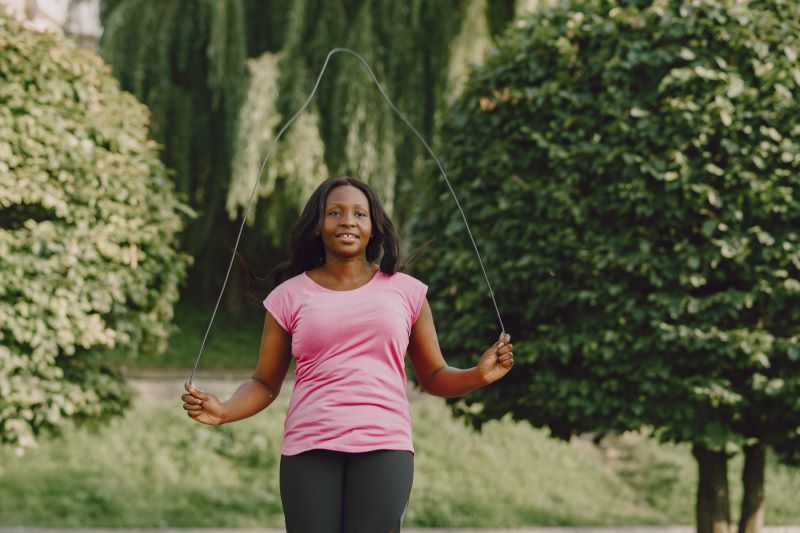Best Exercises for Diabetic Patients for Effective Recovery

Diabetes is a chronic illness that develops when the body either cannot use the insulin that the pancreas makes properly or does not create enough of it. Physical activity is very important for individuals with diabetes. Diabetic patients must remain physically active, making the body more sensitive to insulin.
Insulin is a hormone that allows cells in one's body to use blood sugar for energy, which, in turn, helps one manage his/her diabetes. Interested in learning more about the different exercises for diabetes? Keep scrolling.

Table of Contents

What is Diabetes?
When your blood glucose, commonly known as blood sugar, is too high, you develop diabetes. Your body uses glucose as its primary energy source. Although the body can also produce glucose, it comes from food. The pancreas secretes the hormone insulin, which facilitates glucose uptake by your cells for use as fuel.
High blood sugar levels can potentially harm the body's organs over time. Damage to both large and small blood vessels (microvascular and macrovascular), which can result in heart attacks and strokes, as well as issues with the kidneys, eyes, mouth, feet, and nerves, are potential long-term repercussions.
Symptoms of Diabetes
Your blood sugar level will determine how severe your diabetes is. Some people may not have symptoms, particularly if they have type 2 diabetes, gestational diabetes, or prediabetes. The symptoms of type 1 diabetes typically appear more severely and rapidly.
The following are a few signs of diabetes:
Feeling thirstier than normal
Frequent urination
Reducing weight naturally
Ketones are present in the urine
Feeling feeble and exhausted
Having mood swings or feeling agitated. Blurry vision
Having wounds that heal slowly
Acquiring numerous illnesses, including skin, vaginal, and mouth infections.
Causes of Diabetes
An excess of glucose in the blood brings on any form of diabetes. Nevertheless, the cause of your elevated blood glucose levels varies according to the kind of diabetes you have. Diabetes has several causes, including:
- Insulin Resistance: Insulin resistance results from your muscles, fat, and liver cells not responding to insulin as they should. Several illnesses and circumstances can cause insulin resistance.
- Autoimmune Disease: Your immune system attacking the insulin-producing cells in your pancreas causes type 1 diabetes and delayed onset of diabetes (LAD).
- Hormonal Imbalances: The placenta releases hormones that lead to insulin resistance throughout pregnancy. If your pancreas is unable to produce enough insulin to overcome insulin resistance, you may develop gestational diabetes.
- Pancreatic Damage: Physical damage, such as illness, surgery, or accident, may impact your pancreas's capacity to produce insulin, leading to Type 3c diabetes.
- Genetic mutations: Specific genetic mutations can cause MODY (maturity-onset diabetes of the young) and neonatal diabetes.
18 Best Exercises for Diabetic Patients
Although there are no ways to cure diabetes, one can reverse it. With the help of dietary changes and weight loss, one can keep a check on blood sugar levels. Apart from that, taking proper medications and exercises can also help control blood sugar levels. Here are 18 exercises for diabetes patients that one can incorporate into his/her daily life.
1. Walking

One does not need expensive exercise equipment or a gym membership to get involved in physical activities. If one has a safe place to walk and a supportive pair of shoes, one can start his/her fitness routine.
One can meet his/her recommended target by going for a walk only five days a week. According to studies, people with type 2 diabetes can lower their blood pressure and body mass index HbA1c levels by walking.
2. Cycling

A significant number of individuals with type 2 diabetes also suffer from arthritis. Both these conditions have various risk factors in common, and that includes obesity. Diabetic neuropathy is a condition which might cause joint pain for individuals with type 2 diabetes.
One of the best exercises for diabetics, cycling helps one meet his or her fitness goals while causing less strain on joints.
3. Swimming

One of the best workouts for diabetics is swimming and other aquatic activities like aqua jogging and water aerobics. These joint-friendly aquatic activities give one's heart and muscles a workout while putting stress on one's joints.
4. Aerobic Dance

People with diabetes can sign up for Zumba and other fitness classes, which can help them meet their fitness and exercise goals. Zumba is a type of fitness program that combines aerobic and dance movements and is efficient for a fast-paced workout.
According to a few studies, women with type 2 diabetes have shown more interest in exercising after participating in Zumba classes. By doing it, one can also improve their aerobic fitness and lose weight.
5. Joining Team Sports

If one finds it difficult to engage himself/herself to exercise or lacks motivation, one can join any recreational sports team. It would create an opportunity to socialise with other teammates. One would find it motivating to meet the commitments one makes and show up each week. Moreover, it is a great way to improve sensitivity towards insulin.
6. Resistance Band Exercises

One does not necessarily need to use weights to strengthen his/her muscles; instead, one can also use resistance bands to perform various exercises. To learn how to use them properly, one can seek help from professional trainers, watch videos of resistance band workouts, or take resistance band classes. Exercising with resistance bands can also provide modest benefits in controlling blood sugar.
7. Weightlifting

Weightlifting, along with other strengthening activities, can help one build muscle mass, burn more calories each day, and improve blood sugar control, as per the ADA.
Moreover, one can utilise free weights and weight machines to add weightlifting to one's daily or weekly exercise routine. One can even use household objects like water bottles and canned goods. However, one should seek professional experts' guidance to learn better about weightlifting.
8. Pilates

Pilates is a fitness program that aims to improve core strength, balance, and coordination. Moreover, according to a 2020 study, women with type 2 diabetes who include Pilates in their exercise routine have shown signs of improvement in controlling their blood sugar levels. One can register for Pilates classes at any Pilates studio or local gym.
9. Yoga

Yoga has been working as a low-impact exercise for the past 5,000 years and helps one become more flexible and strong. Yoga involves motions, focus on breathing and poses, which help ease stress and build muscle. This helps in keeping one's blood sugar levels more stable. Yoga also helps in developing balance.
10. Gardening

If traditional exercises do not interest or motivate you, you can try gardening. Gardening is considered strength training and aerobic activity. Bending, walking, and kneeling help improve blood circulation. Lifting, raking, and digging build bones and muscles. Spending time with nature can also help relieve stress.
11. Climbing Stairs

Climbing stairs is one of the most beneficial exercises for type 2 diabetics. Individuals with type 2 diabetes can try climbing stairs as it is one of the easiest ways to burn calories and get one's lungs and heart working faster.
One can try going up and down the stairs for 3 minutes after having a meal. It is a good practice to do this after an hour or two after the meal as it can burn off blood sugar. It is also convenient as one can do it anytime, provided a staircase is present.
12. Tai Chi

Tai Chi is a mild martial art style distinguished by deep breathing and fluid, leisurely motions. It helps increase flexibility, balance, and coordination and lowers a diabetic's chance of falling. Furthermore, studies have demonstrated that Tai Chi lowers blood sugar and enhances general well-being.
13. Circuit Training

Circuit training is a fast-paced workout that involves rotating through various exercises targeting different parts of the body. It combines cardiovascular and strength exercises, improving overall fitness and insulin sensitivity.
14. Rowing

An effective full-body workout that increases cardiovascular endurance and strengthens muscles. Regular rowing can help keep your weight and body fat healthy—both good things for helping control diabetes. Rowing can also help to restore normal glucose metabolism and increase insulin sensitivity. Rowing engages all the major muscle groups.
15. Hiking

Hiking provides both cardiovascular and strength benefits while enjoying nature. In contrast to other, more laborious exercise regimens, hiking could be fun for people with diabetes. Reduced ground reaction forces and balance training may be promoted by hiking.
16. Water Aerobics

Low-impact exercise enhances flexibility, muscle tone, and cardiovascular health. There are several justifications for exercising in the pool. Swimming and other water exercises are easy on the joints and can lower blood sugar. T2D patients may also improve heart health, strength, and general fitness.
17. Jump Rope

While it may not seem like an activity to prevent diabetes, the game we all enjoyed as kids may be a high-intensity, high-energy workout. In addition to increasing heart rate and burning calories, jumping rope improves muscle and endurance. It decreases cholesterol and blood pressure and aids in blood sugar regulation for diabetics. You can jump rope with companions, indoors or out, and create your routine.
18. Callisthenics

Callisthenics involves using your body weight to build muscle. Exercises like push-ups, pull-ups, squats, lunges, and stomach crunches are common examples of callisthenics. Work out all your major muscle groups, whether you prefer resistance bands, weights, or body weight.
Types of Equipment Required for Diabetic Exercises
Certain diabetic patients need some equipment to work and perform the exercises. Here is a list of such equipment necessary for the exercises:
Exercises |
Equipment |
| Cycling | Bicycle |
| Team Sports | Sports Gear |
| Resistance Band Exercises | Resistance Band |
| Weight lifting | Weights |
| Yoga | Yoga Mat |
| Circuit Training | Gym Equipment |
| Rowing | Rowing Machine |
| Aerobic Exercise | Pool Noodle and Swimming Kickboard |
| Jumping Rope | Jump Rope |
How Does Exercising Help Relieve Diabetes?
The benefits of exercise are abundant for individuals with diabetes or any other disease. Besides knowing the exercises for sugar patients, one should also understand how they might benefit.
Being physically active can help one control weight, raise healthy HDL cholesterol, reduce anxiety, lower blood pressure, strengthen muscles and bones, lower harmful triglycerides and harmful LDL cholesterol, and improve overall well-being.
Moreover, exercise has some added advantages for individuals with diabetes, such as countering insulin resistance, lowering blood glucose levels, and boosting one's body's insulin sensitivity.
People from different ethnic groups who have diabetes and are taking medications and following a variety of diets have lowered HbAlc values by 0.7 percentage points with the help of exercise.
Older adults with a sedentary lifestyle with abdominal obesity having a risk of developing diabetes have shown lowered resistance to insulin with the help of exercise. A combination of both aerobic exercises and resistance training is proven to be more beneficial.
Individuals with diabetes have shown a lower risk of dying from heart disease by walking at least 2 hours a week. On the contrary, those who exercise for 3 to 4 hours a week have reduced their risk even more.
The best time to exercise is one to three hours after a meal since blood sugar levels in one’s body might be higher. So, people who use insulin should remember to test their blood sugar levels before starting to exercise.
Which Exercises to Avoid for Diabetes?
Any individual with diabetes should avoid high-intensity exercise if his/her blood sugar level is more than 250 mg/dl. Intense workout sessions can cause a drop in blood sugar levels, which is also known as hypoglycaemia. Apart from that, if one faces any complications while exercising, one should immediately stop and consult a doctor.
What Precautions Should Be Taken While Exercising With Diabetes?
Although exercising should be a vital part of a diabetic’s life, one should remember to take these precautionary measures before exercising.
- Individuals suffering from diabetes should avoid exercising late in the evening since they might develop hypoglycemia during their sleep without even knowing it. Developing hypoglycemia in sleep can even be fatal.
- One must measure one’s sugar levels before starting to exercise. If the blood sugar levels exceed 250 mg/dl, exercise only after the levels drop below 250 mg/dl.
- Diabetics should carry fast-acting carbohydrate foods like glucose tablets, which can come in handy during hypoglycemic episodes.
- Good advice is not to exercise while contracting an infection, as it can affect one's blood sugar levels.
- One should avoid taking insulin shots in body parts that might be used extensively during exercise. If the carbohydrate level in one's blood is not adequate before exercising, blood glucose can be absorbed, leading to hypoglycemia.
- Also, one should avoid exercising alone and always be with someone in case one’s blood sugar levels drop to a lower value.
Disclaimer: Practice the exercises mentioned above under the supervision of a trained practitioner and consult a doctor beforehand to ensure your body is fit enough to perform the required moves/postures.
Incorporating regular exercise into diabetic patients' routines is crucial for effective recovery and overall health. The best exercises for managing diabetes include aerobic activities like walking and swimming, strength training, and flexibility exercises such as yoga. These activities help control blood sugar levels, improve cardiovascular health, and enhance overall well-being.










